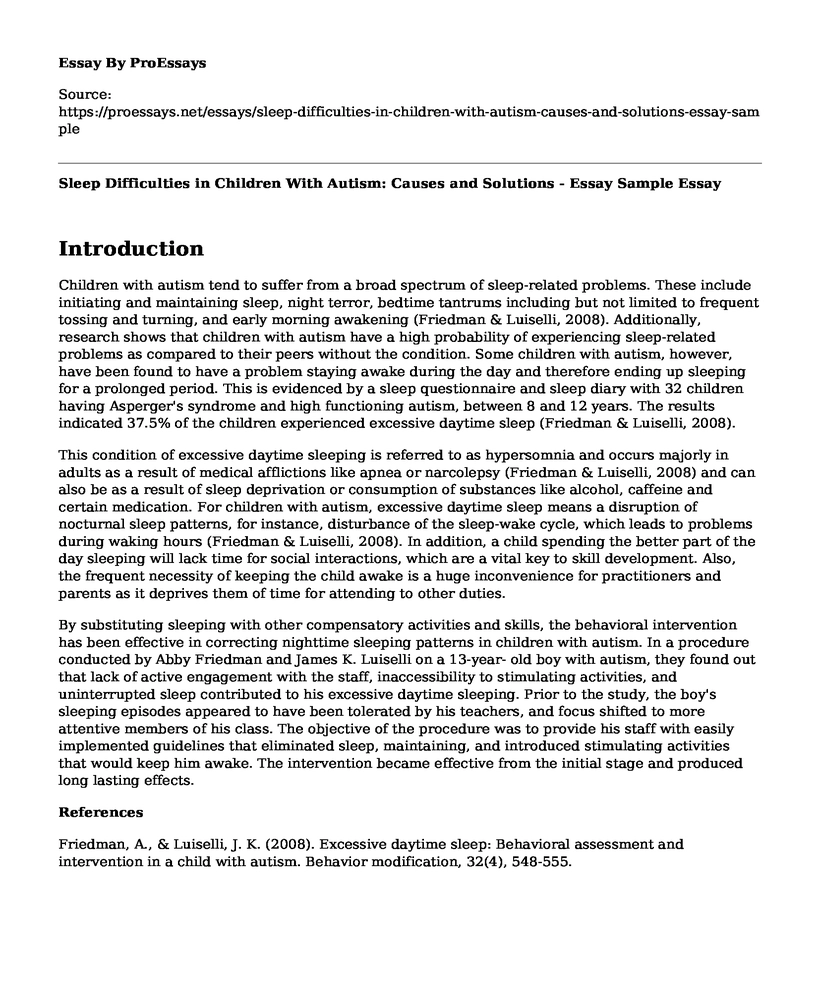Introduction
Children with autism tend to suffer from a broad spectrum of sleep-related problems. These include initiating and maintaining sleep, night terror, bedtime tantrums including but not limited to frequent tossing and turning, and early morning awakening (Friedman & Luiselli, 2008). Additionally, research shows that children with autism have a high probability of experiencing sleep-related problems as compared to their peers without the condition. Some children with autism, however, have been found to have a problem staying awake during the day and therefore ending up sleeping for a prolonged period. This is evidenced by a sleep questionnaire and sleep diary with 32 children having Asperger's syndrome and high functioning autism, between 8 and 12 years. The results indicated 37.5% of the children experienced excessive daytime sleep (Friedman & Luiselli, 2008).
This condition of excessive daytime sleeping is referred to as hypersomnia and occurs majorly in adults as a result of medical afflictions like apnea or narcolepsy (Friedman & Luiselli, 2008) and can also be as a result of sleep deprivation or consumption of substances like alcohol, caffeine and certain medication. For children with autism, excessive daytime sleep means a disruption of nocturnal sleep patterns, for instance, disturbance of the sleep-wake cycle, which leads to problems during waking hours (Friedman & Luiselli, 2008). In addition, a child spending the better part of the day sleeping will lack time for social interactions, which are a vital key to skill development. Also, the frequent necessity of keeping the child awake is a huge inconvenience for practitioners and parents as it deprives them of time for attending to other duties.
By substituting sleeping with other compensatory activities and skills, the behavioral intervention has been effective in correcting nighttime sleeping patterns in children with autism. In a procedure conducted by Abby Friedman and James K. Luiselli on a 13-year- old boy with autism, they found out that lack of active engagement with the staff, inaccessibility to stimulating activities, and uninterrupted sleep contributed to his excessive daytime sleeping. Prior to the study, the boy's sleeping episodes appeared to have been tolerated by his teachers, and focus shifted to more attentive members of his class. The objective of the procedure was to provide his staff with easily implemented guidelines that eliminated sleep, maintaining, and introduced stimulating activities that would keep him awake. The intervention became effective from the initial stage and produced long lasting effects.
References
Friedman, A., & Luiselli, J. K. (2008). Excessive daytime sleep: Behavioral assessment and intervention in a child with autism. Behavior modification, 32(4), 548-555.
Cite this page
Sleep Difficulties in Children With Autism: Causes and Solutions - Essay Sample. (2023, Apr 25). Retrieved from https://proessays.net/essays/sleep-difficulties-in-children-with-autism-causes-and-solutions-essay-sample
If you are the original author of this essay and no longer wish to have it published on the ProEssays website, please click below to request its removal:
- Acute Social Anxiety Disorder
- Experience of 10 Days of Meditation Paper Example
- Paper Example on Psychological Capital and Substance Abuse: A Study on Mental Health
- Witnessing Death: Realizing the Complexity & Impact of Illnesses - Essay Sample
- Essay Sample on Empathy: The Key to Preventing Social Problems Like Bullying
- Emotional & Behavioral Disorders in Children: Causes & Treatment - Essay Sample
- Essay Sample on Overworked & Emotionally Drained: Burnout in the Healthcare Field







